

|
|
 |
 |
 |
 |
// Источник: B.A.F. Newsletter,
Июль 2000, No 36
BACK TO BASICS
SOTAI-DOSA
'Exercises with a partner'
TAI NO TENKAN-HO
'Exercises in Changing Body Direction'
These basic exercises form the foundation of Aikido movement
and need to be practised regularly. Through them we study how
to react to our partner's pulling or pushing.
|
|

Demonstrated and explained by
Kanetsuka Sensei
Photos and text: Peter Megann
Graphics and typesetting: Graham and Laura Jones
Uke: Richard Martin
|
1.Uchi-tenkan ('inner turning') or Irimi ('entering with the body').
In this exercise we move in front of our partner, reacting to his pulling by moving with the pull, rather than opposing it.
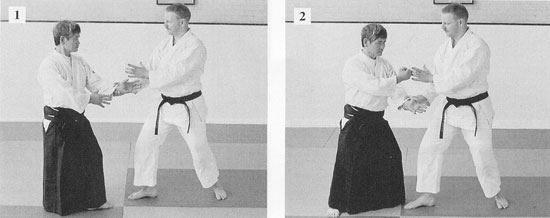
|
Photo 1: Uke takes hold of Tori's left wrist and moves off the attacking line'. The logic behind this movement is that Tori has made an initial strike, so that Uke seeks to control Tori and be in a safe position from which he can in turn attack Tori.

|
|
Photos 2-4: Now that Tori is in a vulnerable position he must move off Uke's 'attacking line'. Because in this situation Uke is pulling, Tori 'goes' with the action and moves towards the front of Uke. He does this by turning his hips to his right (i.e. clockwise), sliding his right toot forward at the same time, so as to change from hidari-hanmi (left posture) on the first contact between him and Uke (in Photo i) to migi-hanmi {right posture), Tori's whole body is involved here, not just his hands and feet. Notice that Tori's left palm is turned up; but he does not move the hand to left or right but keeps it in front of his centre. His weight comes mainly onto the advanced right foot and the knee is well bent (Fig. 1). |
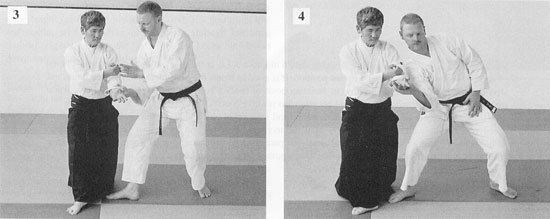
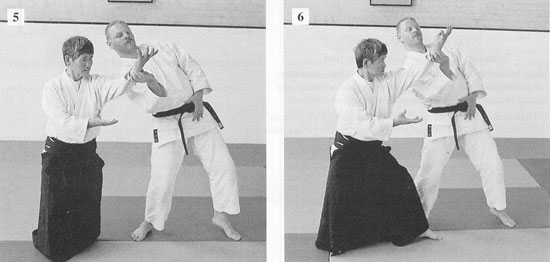
|
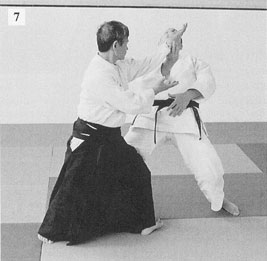 |
|
Photos 5-7: With both palms facing upwards Tori changes the direction of his hips to the left, sliding his left loot past his right fool. At one moment his knees and ankles are almost touching. Shifting his centre of gravity forwards he makes a large step with his left foot, bringing it to a point in between Uke's feet (don't step beyond Uke). Tori's left hand rises in a curve outwards towards Uke's neck; his right hand is level, more or less, with Uke's solar plexus (Fig. 2).
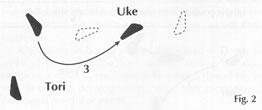
|
|
This movement is often begun from the stage shown in Photo 3, i.e. at the moment of kime (impact). Photos 1 & 2 show how Tori comes to be in that position. It is good to repeat the movement half a dozen times, not too fast, on each side, studying how to maintain positive contact both while moving forward and while moving back. In other words you should not relax this positive contact with your partner as you withdraw.
Things to keep in mind: relax your shoulders; bend your knees well and keep your centre of gravity low: keep your hands in front of your centre until the moment when you cut up against your partner's neck (Photos 5 - 7). Don't simply move parallel to your partner as you advance your left foot: there should be a feeling of entering into your partner's space. Don't push your partner in the last part of the movement. It's a matter of leading his force upwards and away.
2. Soto tenkan ('outer turning')
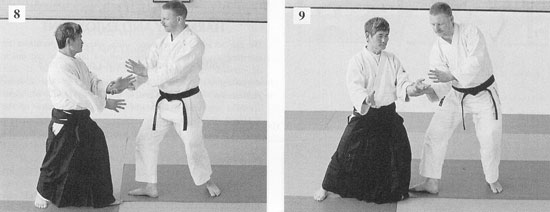
|
|
Photo 8: The action here is basically the same as in Photo 1 (hidari gyaku-hanmi), but Uke is pushing. Tori is not just standing passively. There is a feeling of tsuki (thrusting) towards Uke. Notice Tori's open hands pointing towards Uke.
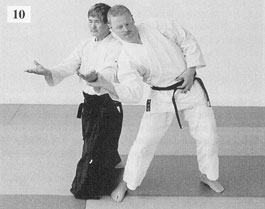
Photos 10 & 11: By turning through an angle of about 95 to Uke's line of attack, Tori deflects Uke outwards and away from him. Notice how this action has twisted Uke's body and affected his posture. Uke's elbow has been bent inwards. Tori's hands are open with the palms facing upwards at the same height (in front of his solar plexus). His posture is low and stable, with a feeling of extension through his arms (kokyu) originating from the back foot. He keeps his elbows down during this turning movement (Fig. 3).
Things to keep in mind: maintain a straight, stable posture throughout the movement. Keep looking straight ahead (me-tsuke): don't look down. Pivot without wobbling. Keep the grasped wrist in front of your centre (don't make a scooping action with it). Keep your nose, hands, hips and feet pointing in the same direction. Don't let the positive contact fade away as you pivot: keep 70% of your weight on the front foot throughout the turn. When you make the first step (Photo 10), don't make the contact of your foot with the tatami too firm and inflexible (it could cause injury to your knee as you twist the leg). Your weight should be on the front part of your foot as you spin round, your leg pivoting from the hip.
|
|
Photo 9: Tori receives Uke's pushing action by making tenkan, i.e. changing direction. Maintaining the thrusting feeling towards Uke's centre with his left hand he changes direction, stepping slightly to the side of Uke, pivoting round the contact point between Uke's hand that has grasped his left wrist. This means that the 'thrusting' is not maintained towards Uke's centre, but the action leads Uke forwards and outwards. As he moves his centre forwards, Tori pivots on the front part of his left foot. It's most important at this point not to lose the positive feeling that he made with Uke at the start of the movement. Tori's left wrist rotates within Uke's grip as the palms of both hands turn upwards.
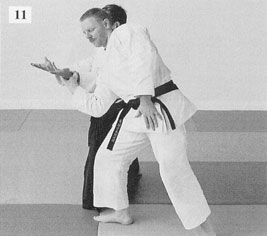
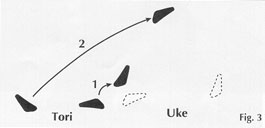
|
Photos 12 - 15: show the movement from migi-hanmi. |
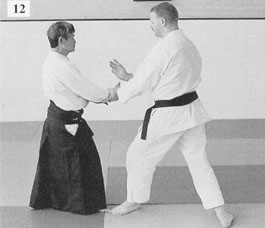
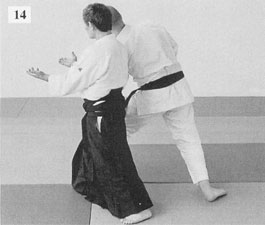
|
|
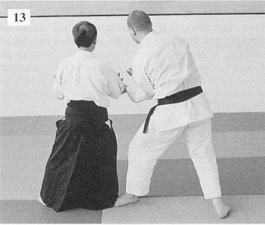
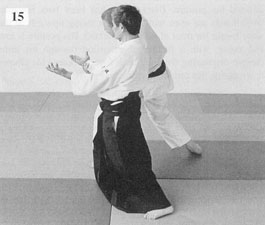
|
|
 |
| |
|
 |
  |
 |
